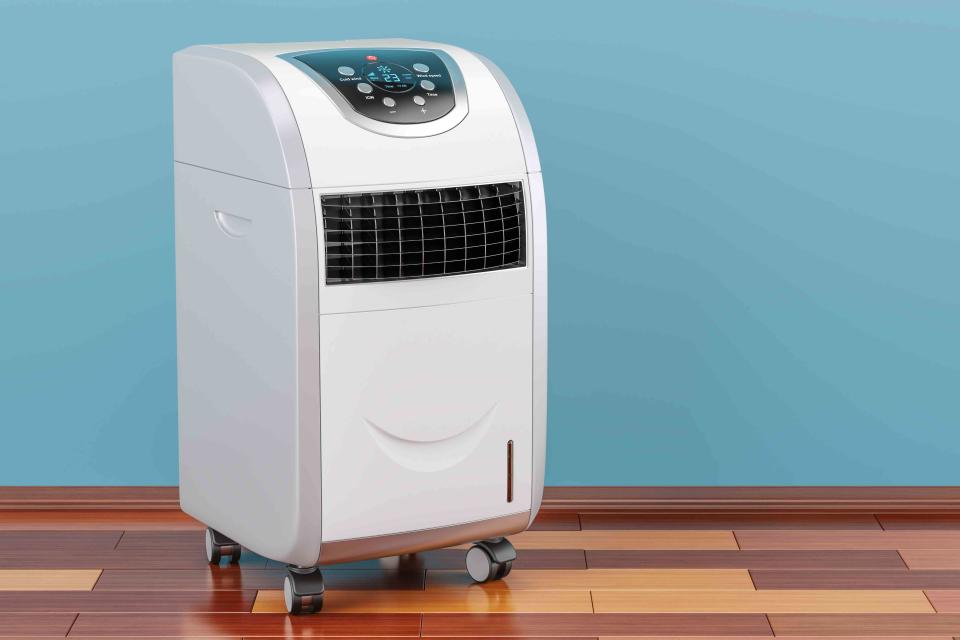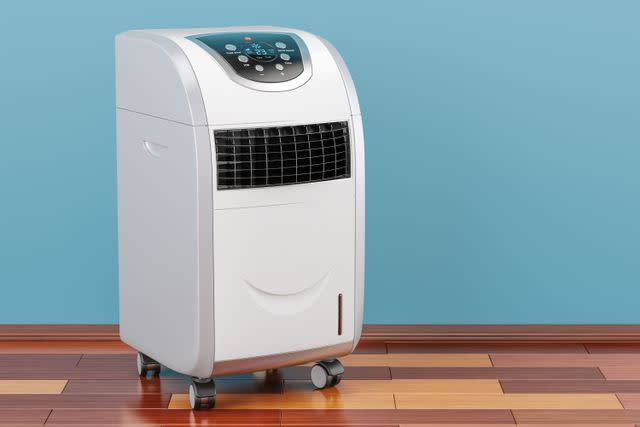Do Portable Air Conditioners Work? Here's Everything to Know About Them
Find out if these cooling devices are the right choice for you.

AlexLMX/Getty Images
As the country faces record high temperatures, the search intensifies for ways to stay cool. Portable air conditioners can help to supplement existing equipment, such as central air or a window AC, or may even help to cool areas without other air conditioning options. But do portable air conditioners really work? And, how do you know if they're the right option for you? We asked an HVAC expert and an indoor air expert to weigh in.
Related: How to Cool Down a Room Without AC

AlexLMX/Getty Images
What Is a Portable Air Conditioner?
Unlike an HVAC (heating, ventilation, and air conditioning) system, mini-split system, or a window air conditioner, a portable air conditioner can be easily moved to other areas of the home. Also, it doesn’t have to be installed permanently, and won’t completely cover the window. Some can be heavy, but are mounted on wheels for portability. Portable air conditioners are available with a single hose or dual hoses (dual hose models cost more and cool faster). Some also include other features, like a dehumidifier and a timer.
How Do You Install a Portable Air Conditoner?
A portable air conditioner undoubtedly has the easiest installation process, but be advised that there is indeed an installation process. Unlike a fan, you can’t just bring it home and turn it on—but unlike a window air conditioner, you won’t need mounting brackets to secure it in place (or an extra pair of hands to lift it up to the window).
“While the unit is portable, a small exhaust will need to be set up through a window with some models, so there are limitations on where it can be placed,” says Brad Roberson, president of Aire Serv in Waco, Texas. After setting up the exhaust in the window, and plugging the unit into an electrical outlet, your work is done. “Some units require a drainage line to remove condensation, and others have a drain pan that must be emptied regularly—but this is one of the easiest options for self-installation, as it tends to come with an installation kit,” he explains.
How Well Do Portable Air Conditioners Work?
Allen Rathey, director of the Indoor Health Council, tells us that he has a portable air conditioner with dual hoses placed in the window of his office—and there are a number of reasons why he chose it. Window AC units are generally thought to be more effective and more efficient at cooling rooms than portable air conditioners, but there are several factors to consider when selecting one or the other.
For starters, you'll want to look at the BTUs—British Thermal Units—to get an idea of the performance ability of either device. When looking for portable air conditioners to remove heat, you may want at least 7,500 BTUs to cool a small space or 14,000 BTUs for a really large area.
Rathey says that portable air conditioners are notably noisier than central AC or Mini-Splits, but comparable in noise to window AC units. “The 14,000 BTU portable air conditioner I use in my office operates at a sound level of 56 dBA," he explains.
It's also worth considering if you want a one- or two-hose option when looking at portable air conditioners. Rathey's two-hose unit both exhausts hot air and brings in outside air for ventilation—and he considers ventilation to be a major feature. “Ventilation is an important factor since window units and even most central AC/HVAC and mini-split systems do not ventilate,” he says. Admittedly, not all portable air conditioners offer ventilation, either, but this was a feature he prioritized when choosing a unit. “There is an energy penalty for bringing outside air indoors, but as health is the main reason for my choice, I went with this model,” he says.
However, if your outdoor air is polluted or it’s very hot, Rathey says you can disconnect the outside air intake and just cool and recirculate the indoor air.
So, while the performance of a portable air conditioner may be the same—or even more costly to your energy bills—as a window AC unit, some other qualities, like versatility and ventilation, may influence your choice.
How Much Do Portable Air Conditioners Cost?
Portable air conditioners tend to be more expensive than window AC units—and they tend to use more energy compared to whole-home HVAC systems.
They also tend to cover the smallest range for cooling a home, Roberson says. “Those looking only to cool a few square feet may consider this a budget-friendly option from as low as $100 to $200,” he explains. But the larger the space, the more BTU’s you’ll need. “More BTUs mean more energy use and a higher purchase price,” he adds.
Fortunately, the square footage coverage is usually listed on the packaging. So, measuring your space can help you decide how many BTU’s you’ll need.
Related: How to Choose the Right Size AC for Your Space
To assist in your research and decision making, we found a variety of portable air conditioners in a variety of sizes and price points. For example, The Delonghi PACEX39OUVcare-6AL Portable Air Purifier retails for $679 (definitely top of the line), but it has 14,000 BTUs and can cool 700 square feet. The air purifier also has a dehumidifier, fan, UV-C technology to protect against viruses, a programmable timer, and a remote control. The silver ion washable filter traps dust, hair and other debris, and the handle and wheels make it easy to transport.
The 3-in-1 TCL W8P95 Smart Portable Air Conditioner ($378) has 8,000 BTUs and can cool a room up to 325 square feet. It can also be used as a fan or a humidifier and works with both vertical sliding and horizontal sliding windows. The handles and wheels make it easy to glide, and the air conditioner can be controlled via the TCL app via phone, or with Alexa and Google Assistant.
Also worth noting: We found several models online advertised as portable air conditioners that were much cheaper, but upon closer inspection, they were actually evaporative coolers or swamp coolers that use water to cool the air.
For more Real Simple news, make sure to sign up for our newsletter!
Read the original article on Real Simple.

